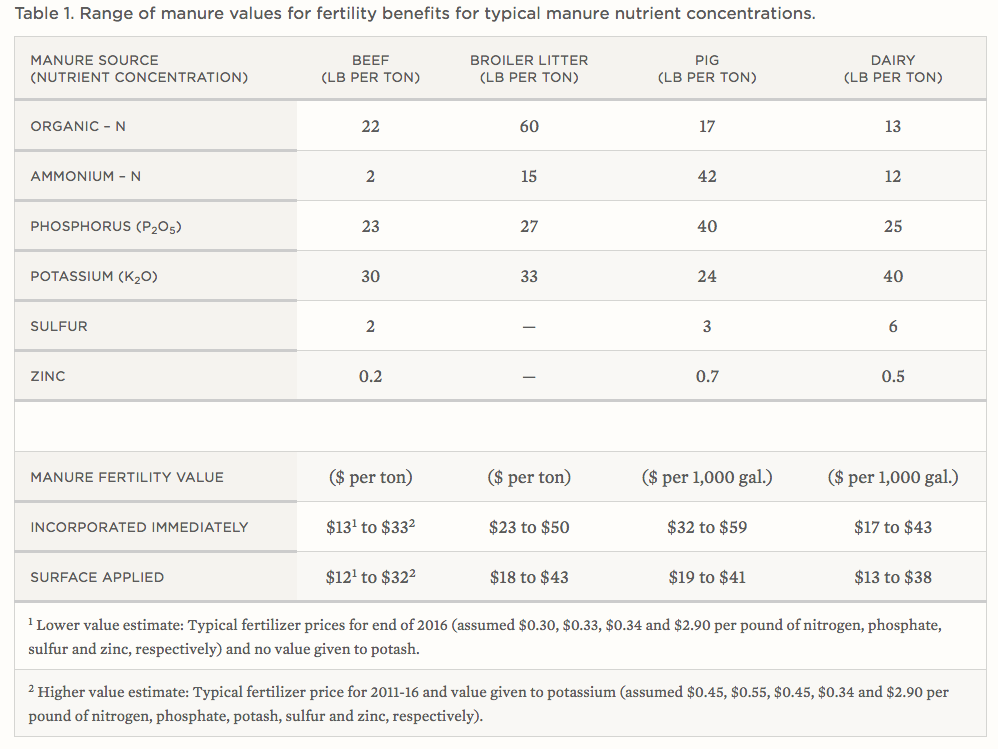Manure has the potential to be both an economic “win,” due to its fertility value, and a soil quality/health “win,” due to the organic matter that fuels the activity of soil-dwelling organisms. In the right situations, soil quality benefits can improve drought resilience and water quality.
The impacts of manure will vary from field to field. Identifying those fields with the greatest potential for a win-win opportunity is the challenge of every farmer using manure.
These win-win opportunities result from manures:
- nutrient substitution for commercial fertilizer;
- organic matter contributing to soil quality improvements; and
- potential to achieve a possible yield boost.
This is the first article of a two-part discussion and focuses on manure nutrient substitution for commercial fertilizer. Part two will address the soil quality benefits provided by manure.
Manure Fertility Benefit
Manure contains nutrients important to crop growth. Manure nitrogen (N) is typically 50-90% organic N, which is slowly released as soils warm in the spring and summer. Credits for a single-year application of organic N occur over multiple years. Typically, 25-40% of the organic N is available in the crop year manure is applied with roughly half that amount becoming available with each succeeding year (roughly 15% in year 2, 7% in year 3, etc.). Most manures also contain ammonium N, a fast-release form of N, which must be incorporated or irrigated into the soil for its value to be realized.
Manure also contains phosphorus (P) and potassium (K), although not always in the right ratio to match crop needs. Applying manure to meet most of the crop N needs generally exceeds the P needs of the crop by 3-5, or more, times. Manure P generally does not move through the soil, but it can run off with soil runoff and erosion. Additional micronutrients such as sulfur and zinc are also found in manure. These nutrients are largely in their organic form in manure, making them readily available in the crop year following application.

Based on assumptions relevant to an individual field situation and whether manure is incorporated to conserve the ammonium-N, manure may have a value in the range shown in Table 1. For a 20 ton-per-acre application of beef manure solids, the value per acre would range from $240-$660 per acre. Note the critical importance for feedlot manure is to place it on fields requiring P if you want to achieve an economic “win” (Figure 1).
 Figure 1.
Figure 1.
For other manures, the organic and ammonium-N can be equally critical to the value of manure. Fields that also have low soil K levels will gain significantly greater value from manure. Selecting fields/crops carefully will produce a benefit closer to the $660-per-acre benefit for a 20-ton-per-acre beef manure application.
Because manure nutrient content varies greatly among species and the manure storage and handling methods employed, it is best to determine a value for the specific manure to which your farm has access. With a manure sample specific to your manure source and a worksheet for estimating manure value (e.g., Calculating the Value of Manure for Crop Production) or an online or spreadsheet tool (e.g., Nebraska Manure Value Calculator), farm-specific estimates of manure value can be made.
How to Get the Most Value from Your Manure Application
To achieve a higher economic “win” from manure’s fertility value:
- Prioritize application to fields with soil P concentrations of 20 ppm or less (Bray soil test).
- Avoid annual manure applications on the same field. Wait for soil P concentrations to return to a 20 ppm target before reapplying manure. Often this means delaying manure application for 3-8 years.
- Apply manure ahead of non-legume crops benefitting from supplemental N.
- Conserve the ammonium N value of manure by incorporating the manure into the soil immediately. This is especially important for swine and dairy slurry manures, but of little value for open lot beef manure.
- Credit the manure’s organic N for the second and third cropping years after a manure application. A soil test will not give credit to residual organic N in the soil. For estimating these credits, see Determining Crop Available Nutrients from Manure (NebGuide G1335).
- Target fields requiring K, sulfur, or micronutrients. Fields requiring K experience a much greater economic return from manure application (see Figure 1).
- Apply manure at a rate less than the N requirement of the intended crop, and then sidedress the crop with commercial fertilizer based upon in-season soil or crop N measures.
Additional Resources
In 2016, researchers and extension faculty in the North Central Region joined to develop a website and blog, Soil Health Nexus: University research-based soil health resources no one should be without. A new section being developed within that site addresses the value of manure to soil health, integrating manure into soil management strategies, and identifying needed research. The current article is "Manure and Soil Health: What is the State of the Science?"
For more information see these Nebraska Extension resources:
- Determining Crop Available Nutrients from Manure (NebGuide G1335)
- Calculating the Value of Manure for Crop Production (NebGuide G1519)
- Nebraska Manure Value Calculator





